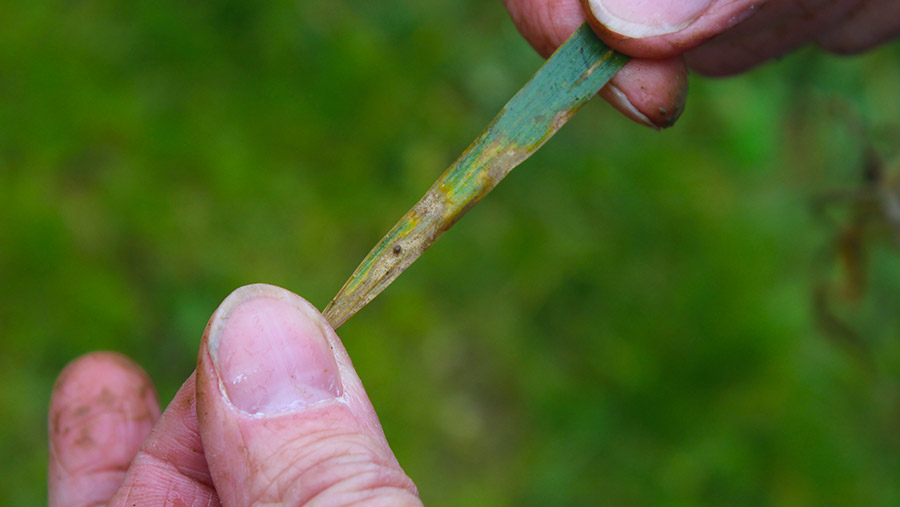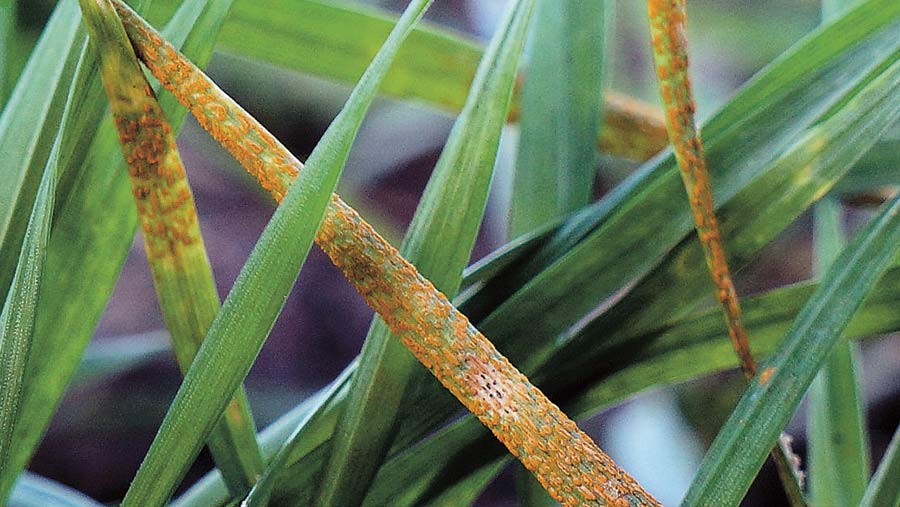Competition to give some respite on fungicide price rises
Stiff competition in the cereal fungicide market is set to limit expected prices rises as growers face a disease-fighting season, trying to control more virulent yellow rust races and plenty of septoria.
Two major new SDHI-azole fungicide products will be available this spring season, increasing the choice for cereal growers and so keeping some pressure on prices.
All SDHI and azole cereal fungicides are imported and therefore are expected to become more expensive because of the recent weakness in the pound.
See also: Ultimate guide to wheat diseases
However, new products launches such as Ascra and Elatus will make this a crowded marketplace for SDHI-azole combinations and may keep a ceiling on price rises.
The price of the major T1 and T2 fungicide sprays this year could range from £30/ha up to as much as £50/ha when using some of the new products and mixtures for this season.

Early septoria in wheat © Oli Hill/RBI
This comes at a time when growers are facing an increased threat from new highly infectious races of yellow rust as well as concerns over septoria resistance to fungicides.
Whereas the incidence of yellow rust is somewhat lower than last season, there is sign of septoria in virtually all wheat crops just waiting to explode if the spring weather turns wet.
Plenty of inoculum
Bill Clark, fungicide expert at crop consultancy Niab, says there has been enough frost and cold to slow down yellow rust development through the winter, although there is plenty of septoria inoculum in crops.
“The general disease pressure is lower this season, but disease could be serious on some varieties with lower resistance ratings,” he tells Farmers Weekly.
Jonathan Blake, at fellow consultancy Adas, says septoria could become a problem if the weather turns wet in the lead-up to the T1 spray timing, which is usually about the end of April.
Video: How to get wheat T1 fungicide timings spot on
Luke Wheeler, Midlands-based agronomist with independent agronomy group Indigro, demonstrates how to disect a wheat plant to tell if it’s time for a T1 fungicide spray.
“Septoria is present in most crops, so there could be a significant risk of the disease developing if we see rain in March and April,” he says.
The wet-loving septoria is the biggest yield-sapping disease of wheat, and the move towards later drilling, largely to control blackgrass, will have helped suppress disease pressure.
“If you grow a variety with a 5 or 6 score for septoria and you drill it in September, then you can take that rating down a point,” says Mr Clark.
The variety factor

Bill Clark
Varieties are rated on a 1-9 scale for septoria, with 1 being poor and 9 meaning good tolerance, and range from Santiago on 4.3 to Sundance on 7.3.
On yellow rust, wheat varieties with low resistance scores of 3 to 6 should be checked regularly – especially important for the more popular varieties such as Reflection (3) and Cordiale and Gallant (both 4s).
Even those with highest resistance scores such as Siskin, Crispin and Costello (all 9s) should still be checked because of the new virulent Warrior race and others that have resulted in rating downgrades to some varieties.
See also: Wheat varieties get sharp downgrade in yellow rust ratings
Looking at the wide array of products on the market, Mr Clark says the timing of fungicide sprays is more important than actual products, which tend to show only subtle differences.

Septoria in winter wheat © David Jones/RBI
He advises growers to look at an azole and a multisite such as chlorothalonil for a T0 spray, which tends to occur in late March and is aimed at protecting leaf four.
The timing of the T0 spray tends to depend on what growers see in the field and can be earlier if yellow rust is seen.
Growers might get away with just chlorothalonil, but he advises that the rust pressure is high enough for an azole.
Two-SDHI strategy
The big question for later in the season is the use of one SDHI or two, and Mr Clark’s current advice is to use two SDHIs and then adjust rates.
It is strongly recommended to use SDHI fungicides in tandem with another fungicide that offers a different mode of action, such as an azole, to prevent resistance building up.
The SDHI component is the key part of septoria control as azole efficacy against the disease has declined, while yellow rust can be controlled by other fungicide groups, including azoles or strobilurins.

Jonathan Blake
“The best approach is to use the best product and then adjust the dose rate to the disease pressure,” says Mr Clark.
Using late-drilled wheat varieties with good yellow rust resistance such as Siskin, Crispin and Costello, growers could get away with an azole-chlorothalonil at T1, but there is a risk of getting it wrong.
“I would probably always use a SDHI twice on the majority of varieties and then adjust the rates at T1,” he says.
Mr Blake adds that all the available SDHI products have good efficacy on septoria, and believes it is too early to decide definitely on a one-SDHI or two-SDHI strategy.
See also: Video: How to properly set up a crop sprayer
“Much depends on rainfall up to and around T1. But with later-drilled disease-resistant varieties and a dry period of weather, growers may be able to cut back,” says Mr Blake.
In this situation, he believes growers may be able to omit the SDHI at T1 and just go with an azole-chlorothalonil, which would help with resistance management by limiting the use of SDHIs in a season.
New products
For this season, Syngenta is launching its new Elatus product, which contains a new SDHI plus the azole prothioconazole, and is aiming this at the T2 flag leaf market, while its older SDHI-azole mix, Keystone, is targeted at T1.
Bayer’s new product Ascra contains two existing SDHIs and the azole prothioconazole and is aimed at the T2 slot, while its older Aviator product is focused on the T1 position.
See also: Video: How to get wheat T1 fungicide timings spot on
BASF will continue to market its SDHI-azole Adexar at T1 and either Adexar or Librax – which contains a different azole – at the T2 stage.
DuPont will market its Vertisan as a straight SDHI product, giving growers the choice of which azole to add. It is marketed mainly at the T1 stage, because of its claimed benefit of increasing plant rooting.
Shifting yellow rust strains
A strategy of two SDHIs is generally advised by Clare Bend, head of technical at agronomy group Agrii, because of the resultant yield benefits. It also prevents putting SDHIs under too much pressure.

Early yellow rust © Blackthorn Arable
She adds that the benefits of using an SDHI at T1 including boosting winter wheat yields by 0.5-0.75t/ha, according to the company’s trials, while good disease control at T0 and T1 will put an SDHI under less pressure when used at T2.
“Using two SDHIs is the only way to control septoria in a high disease pressure situation. However, they must be used with both azoles and multisite partners to minimise selection for septoria resistance,” she says.
Many growers have moved to selecting winter wheat varieties with reasonable septoria resistance and this focus on genetics will be increasingly needed.
Active ingredients
- Aviator – SDHI bixafen plus azole prothioconazole
- Ascra – SDHIs bixafen and fluopyram plus azole prothioconazole
- Adexar – SDHI fluxapyroxad plus azole epoxiconazole
- Librax – SDHI fluxapyroxad plus azole metconazole
- Keystone – SDHI isopyrazam plus azole epoxiconazole
- Elatus – SDHI benzovindiflupyr (solatenol) plus azole prothioconazole
- Vertisan – SDHI penthiopyrad
- Tracker – SDHI boscalid plus azole epoxiconazole
“However, we need to be mindful of shifting yellow rusts strains and to watch those varieties with low brown rust resistance, such as Crusoe.
“The new SDHI solatenol seems to be particularly strong on this disease so may be a useful option here,” she adds.
A two-SDHI fungicide strategy in winter wheat is also recommended by Paul Fogg, fungicide expert at fellow agronomy group Frontier.
He says that, with yellow rust and septoria easy to find in most wheat crops, there is potentially a big disease threat this season, so a greater choice of products will give growers more options.
See also: Early wheat disease control vital to fight rusts and septoria
“A two-SDHI programme will buy flexibility and allow growers to manage their fungicide rates,” Mr Fogg says.
With late-drilled wheat crops and using a disease-tolerant variety, then a T1 might be just an azole plus a multisite, but he would prefer to use an SDHI along with an azole and a multisite at T1 and then adjust rates according to risk.
Disease pressure will depend on rainfall over the next few weeks, so if it is dry then the T1 SDHI rate can be tweaked downwards to save some money and still give good control.
Cost will be key
Independent agronomist James Rimmer, who covers Kent and parts of Sussex for CCC Agronomy, says wheat disease levels are generally low but he predicts rust could be a problem later this season.

James Rimmer
“It does feel like it could be a rusty year, so strobulirins could well be very important at T1,” he tells Farmers Weekly.
For T1, Mr Rimmer thinks the older-generation SDHI boscalid with epoxiconazole plus chlorothalonil will be a good fit, and adds this can be “topped up” with a new-generation SDHI where septoria pressure is greater.
More rust-prone wheat varieties may get a strobulirin added at this T1 stage for increased control.
He will look to use one of the newer-generation SDHIs at T2, but his strategy at this stage will depend a lot on previously applied products as he prefers to use different azoles throughout the programme.
See also: Video: How to properly set up a fertiliser spreader
If epoxiconazole is used at T1, then it is likely that Mr Rimmer will opt for an SDHI with the azole prothioconazole, such as Aviator, at T2.
“All the main SDHI products will have a role at T2 based on variety and disease pressure at the time. Elatus and Ascra will be used field-scale for the first time, when and if applicable,” he adds.

Luke Wheeler © Oli Hill/RBI
In the West Midlands, Luke Wheeler of independent agronomy group Indigro says there is a lot less disease around compared with last season because of the dry and cool conditions.
The choice of wheat varieties will make a big difference to T1 programmes and adds that he will be looking for eyespot if the weather is wet and warm.
“If at T1 we are seeing septoria on newly emerged leaves, we will need to go in with an SDHI. But if it is clean and dry we may just use an azole. Whatever azole I use, I will try to use a different one at T2,” he adds.
Product price will have an influence on choice at T2 and he hopes that the added competition this season will help to keep prices from rising too much.
“To be honest, you could choose any SDHI and be happy with the performance, so it will come down a lot to price as there is a range of good products available,” he says.

